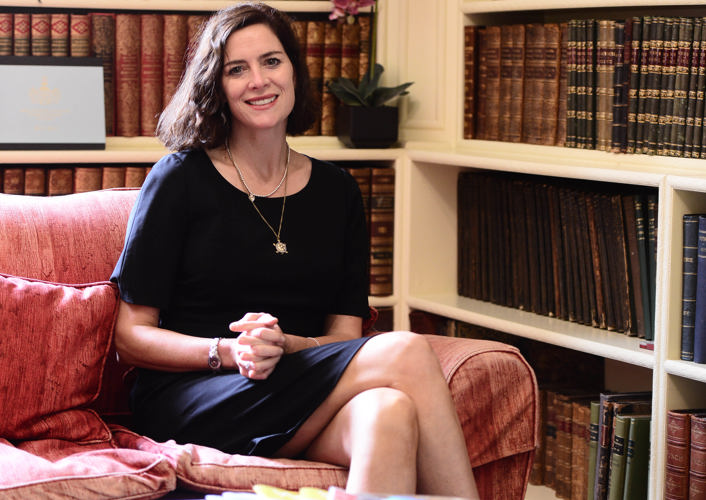Science and Femininity – time for a redefinition?

What’s making the UK suffer from a lack of women in STEM careers? Jane Lunnon, Head of Wimbledon High School, wants to inspire the next generation of females into Science, Technology, Engineering and Maths...
It is Saturday morning and I am sitting in my local hairdressers, reading the latest IPPR report (Institute for Public Policy Research - tweeted by Helen Fraser), which details the chronic shortage of female engineers in the UK. Only 21% of girls opt for Physics at A level, only 7% of the engineering workforce is female, nearly half of all maintained co-ed schools in England (49%) have no girls taking A Level physics and, perhaps most shockingly, the UK has the lowest percentage of female engineering professionals in Europe – less than 10%.
None of this is news of course and the IPPR acknowledges this. It asks why things have come to such a pretty pass in the UK in particular and concludes in a rather un-revolutionary way, that girls are not opting for STEM subjects (Science, Technology, Engineering, Maths) after GCSE because they do not regard these subjects as essentially feminine. Hmmm… as conclusions go, that’s not exactly rocket science. (Or even, mechanical engineering.) I’d be much more interested in asking: why this is felt so particularly strongly in the UK? What is it in our education system, our family structures, our water – which makes some girls so averse to the wonder of numbers, theory, scientific concepts and practical work once they get to the critical age of 15?
At the age of 7, they may have loved planets, mushrooms, stones, fossils, breeding their own earthworms, making their own transformers… But what happens to these girls that, when it comes to choosing A level options, they might no more opt for Physics, Chemistry or Biology A level than fly to the moon - let alone design the spaceship to get themselves there?
Why do so many girls in the UK allow their femininity to be so cribbed and confined? Well, the report offers a number of explanations. Key amongst them is the unwitting gender bias expressed by teachers, students, whole institutions offering well-meaning advice that warns girls away from “seriously hard” Physics because they may not get their A in it. Leaving aside the depressing assumptions here (education is just about the exam results, always aim for the easier route), it seems that we have a very real problem.
At Wimbledon High School (WHS), over 50% of girls choose to do a STEM subject at A Level – 100% more than the average… why? Well, it’s a girls’ school. There are no supremely confident boys around asserting their scientific superiority, or, perhaps more insidiously, asserting the essential undesirability of girls who opt for Physics, Chemistry or Biology. I was talking this issue over with a good friend of mine who has a stunning career in medical research. She was one of only two girls in the 1980s who opted for Physics A Level at her school. And the boys regarded her as some kind of interesting science experiment, an anomaly… certainly not a “girl” in the same way as the Larkin-quoting English students. Having only recently moved into a single-sex environment, every day I delight in the fact that the WHS girls are not defining who they are or what they care about academically in opposition to boys. And my goodness, it is working for them.
Because it’s not just about opting to do it. It’s also about believing you can. Girls at WHS tend to start with the view that they “can do stuff” and that if they can’t do it at any point, part of the fun of the thing will be to work out how to do it. That’s great if you’ve got it – and thank goodness for 150 years of GDST history that has allowed girls to think in this way – this kind of confidence and self-assertion is embedded in the wooden panelled walls of the schools – girls can do anything they put their mind to… and they simply get on with it.
But what do we do about the many thousands of girls for whom this kind of resilience and self-belief is not the norm? Well, the IPPR report suggests mentors in schools – explaining what engineering is and what a life in STEM might look like. Yes, good idea. It suggests compulsory training for teachers to address, head on, any innate gender assumptions they may be inclined to make. Yup, another good plan.
Yet it feels to me, 100 years on, like a fight on the scale of the suffragettes. It’s all very well telling girls to chain themselves to fences or to burn their (carefully engineered) bras, and some will don their hard hats and get on with it. I think, however, we have to be realistic and pragmatic and look for other ways of reaching the bright female talent pool. If the issue is about how teenage girls perceive STEM subjects and the engineering careers that follow, if they regard them, currently, as essentially unfeminine and unglamorous, doesn’t our definition of femininity need to be redefined?
There are some campaigns on YouTube aimed at girls and young women:
http://www.youtube.com/watch?v=Q_11rwb4vEc http://www.youtube.com/user/forwomeninscience
Let’s do more of that. Let’s spread the message that femininity can and should be as much about knowing what you want to do and going out to get it – the job that you want rather than that you are being stereotyped into – and move away from narrow definitions.
Our speaker, Dr Sujata Kundu, said in this week’s Cocktail Chemistry lecture that rockets and funky shoes can be made from the same material; here’s to a future where ever more scientists and engineers are no longer cut from the same cloth.
